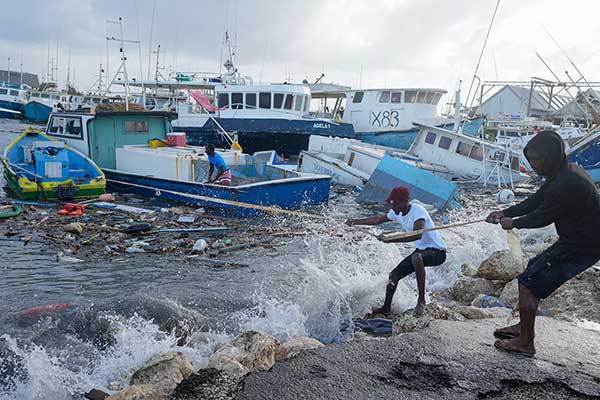Warmer Water Can Lead to Stronger Hurricanes

CEE/MES Professor Qin Jim Chen explains that the high ocean temperatures are a factor in Hurricane Beryl’s record-breaking development and predicts a busy hurricane season.
This article originally appeared on Northeastern Global News. It was published by Alena Kuzub. Main photo: Fishermen pull a boat damaged by Hurricane Beryl back to the dock at the Bridgetown Fisheries in Barbados, Monday, July 1, 2024. AP Photo/Ricardo Mazalan
Why did Beryl develop into a record-setting hurricane? High ocean temps and other factors are to blame, Northeastern expert says
Jim Chen, a professor of civil and environmental engineering and marine and environmental sciences, expects a lot of strong hurricanes this year that will require preparation to mitigate impact.
A historic hurricane is rapidly making its way through the Caribbean Sea to the Gulf of Mexico.
Beryl turned into a Category 5 hurricane Monday night and is expected to strike Jamaica on Wednesday, according to the National Hurricane Service Center.
The early-season hurricane will likely bring heavy rainfall and flash flooding to the island as well as strong winds capable of causing devastating to catastrophic damage and loss of life.
“The peak [of the hurricane] season usually occurs in late August and September,” says Jim Chen, Northeastern University professor of civil and environmental engineering and marine and environmental sciences.
Beryl is the first Category 4 hurricane recorded in the month of June and the earliest Category 5 storm on record in the Atlantic Ocean hurricane season.

Jim Chen, professor of marine and environmental sciences. Photo by Matthew Modoono/Northeastern University
“Never has a hurricane with such power come early in July,” Chen says.
Beryl ultimately is on the path to reach the Yucatan Peninsula of Mexico, Chen says, and could potentially affect Texas and Louisiana.
“Hurricanes like Hurricane Katrina, for example, even if they are 100 miles or 200 miles away, still, you feel the impact of wind and storm surge,” he says.
Northeastern Global News spoke to Chen about the causes of such a powerful storm, the likelihood of it making a downfall in the U.S. and long- and short-term preparation measures anyone can take.
Read full story at Northeastern Global News